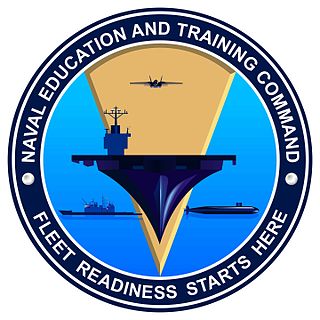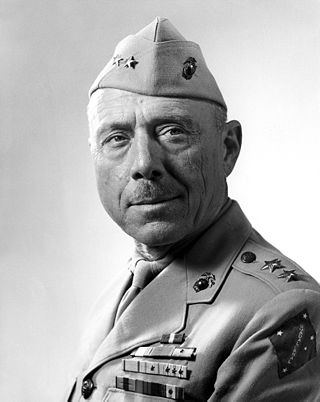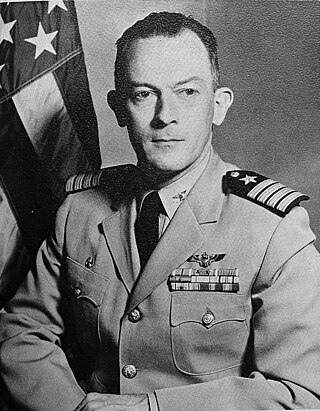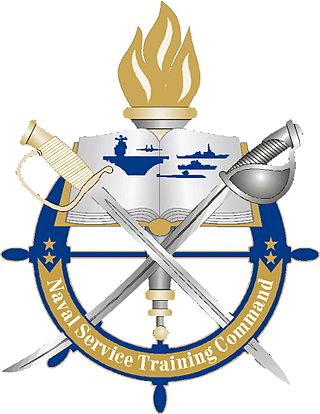Related Research Articles

The United States Coast Guard (USCG) is the maritime security, search and rescue, and law enforcement service branch of the United States Armed Forces and one of the country's eight uniformed services. The service is a maritime, military, multi-mission service unique among the United States military branches for having a maritime law enforcement mission with jurisdiction in both domestic and international waters and a federal regulatory agency mission as part of its duties. It is the largest coast guard in the world, rivaling the capabilities and size of most navies.

Elmo Russell "Bud" Zumwalt Jr. was a United States Navy officer and the youngest person to serve as Chief of Naval Operations. As an admiral and later the 19th Chief of Naval Operations, Zumwalt played a major role in United States military history, especially during the Vietnam War. A decorated war veteran, Zumwalt reformed United States Navy personnel policies in an effort to improve enlisted life and ease racial tensions. After he retired from a 32-year navy career, he launched an unsuccessful campaign for the United States Senate.
The Ranger Creed is the official creed of the United States Army Rangers. The Ranger Creed was written in 1974 by CSM Neal R. Gentry, the original command sergeant major of the reactivated 1st Ranger Battalion. It was initiated by the Battalion Commander, then-LTC Kenneth C. Leuer, and re-drafted by the battalion XO, MAJ "Rock" Hudson and finalized at Fort Stewart, Georgia in 1974 when the original cadre deployed there on 1 July 1974. Today, members of Ranger community recite the Ranger Creed during formations, ceremonies, physical training activities and upon graduations from the Ranger Indoctrination Program, the Ranger Orientation Program and the U.S. Army Ranger Course.

The master chief petty officer of the Navy is a unique non-commissioned rank and position of office of the United States Navy, which is designated as a special paygrade above E-9. The holder of this position is the most senior enlisted member of the U.S. Navy, equivalent to the sergeant Major of the Army, chief master sergeant of the Air Force, sergeant major of the Marine Corps, master chief petty officer of the Coast Guard, and chief master sergeant of the Space Force. The holder of this rank and position is the most senior enlisted sailor in the Navy, unless an enlisted sailor is serving as the senior enlisted advisor to the chairman. The current MCPON is James Honea.

Harry Gabriel Hamlet was the seventh Commandant of the United States Coast Guard, from 1932 to 1936.
A shipmate is a mate on one's own ship.

The Soldier's Creed is a standard by which all United States Army personnel are expected to live. All U.S. Army enlisted personnel are taught the Soldier's Creed during basic training, and recite the creed in public ceremonies at the conclusion of training. Both the Soldier's Creed and the Noncommissioned Officer's Creed are required knowledge at enlisted promotion boards to compete for the rank of sergeant and above, as well as 'Soldier of the Month' boards. It is also common practice to recite the Soldier's Creed at the graduation ceremony from Army ROTC. Unlike the U.S. Uniformed Services Oath of Office or the Oath of Enlistment, the Soldier's Creed is not a legally-binding oath and can be affirmed by both commissioned officers and enlisted soldiers.

The Naval Education and Training Command (NETC) is an enterprise-level shore command of the United States Navy with more than 19,000 military and staff personnel at more than 1,640 subordinate activities, sites, districts, stations, and detachments throughout the world. NETC recruits, trains and delivers those who serve the nation, taking them from "street to fleet" by transforming civilians into highly skilled, operational, and combat ready warfighters.

William Porter "Bill" Lawrence was a decorated United States Navy vice admiral and Naval Aviator who served as Superintendent of the United States Naval Academy from 1978 to 1981. Lawrence was a noted pilot, the first Naval Aviator to fly twice the speed of sound in a naval aircraft, and one of the final candidates for the Mercury space program. During the Vietnam War, Lawrence was shot down while on a combat mission and spent six years as a prisoner of war, from 1967 to 1973. During this time, he became noted for his resistance to his captors.

The Rifleman's Creed is a part of basic United States Marine Corps doctrine. Major General William H. Rupertus wrote it during World War II following the attack on Pearl Harbor between late 1941 and early 1942, but its first publication was in San Diego in the Marine Corps Chevron on March 14, 1942. His reasoning for writing the Creed is believed to be that he felt that his men had to understand the concept "that the only weapon which stands between them and Death is the rifle…they must understand that their rifle is their life…"

Vice Admiral Melvin Gene Williams Jr. is an American retired officer in the United States Navy. He is the former Commander, U.S. Second Fleet and former Director, Combined Joint Operations from the Sea Center of Excellence.

James Lemuel Holloway Jr. was a four-star admiral in the United States Navy who served as superintendent of the United States Naval Academy from 1947–1950; as Chief of Naval Personnel from 1953 to 1957; and as commander in chief of all United States naval forces in the eastern Atlantic and Mediterranean from 1957 to 1959, in which capacity he commanded the 1958 American intervention in Lebanon. As founder of the Holloway Plan, he was responsible for creating the modern Naval Reserve Officer Training Corps.
The U.S. Army Creed of the Noncommissioned Officer, otherwise known as the Noncommissioned Officer's Creed, and commonly shortened to the NCO creed, is a tool used in the United States Army to educate and remind enlisted leaders of their responsibilities and authority, and serves as a code of conduct. Each branch has their own version, and many have been altered over the years.

The Creed of the United States Coast Guardsman was written in 1938 by Vice Admiral Harry G. Hamlet, who served as Commandant of the Coast Guard from 1932 to 1936. According to former Commandant Robert Papp, the Creed described the duties and responsibilities that binds the group of Coast Guardsmen together as "shipmates".

John Kingsman Beling was a rear admiral of the United States Navy whose final assignment was as commander, Iceland Defense Force in the early 1970s. Commissioned in 1942, he served as a Naval Aviator in the Pacific Theater in World War II, and was seriously burned when his aircraft was shot down during the Marianas Campaign. He made a full recovery from his injuries, and went on to serve in a variety of staff positions, attended the Naval War College, and commanded three attack squadrons and two ships.

The Junior Reserve Officer Training Corps is a federal program sponsored by the United States Armed Forces in high schools and also in some middle schools across the United States and at US military bases across the world. The program was originally created as part of the National Defense Act of 1916 and later expanded under the 1964 ROTC Vitalization Act.

The Master-at-Arms (MA) rating is responsible for law enforcement and force protection in the United States Navy—equivalent to the United States Army Military Police, the United States Marine Corps Military Police, the United States Air Force Security Forces, and the United States Coast Guard's Maritime Law Enforcement Specialist. It is one of the oldest ratings in the United States Navy, having been recognized since the inception of the U.S. Navy.

The Naval Service Training Command (NSTC) is a one-star echelon III command of the United States Navy that is responsible to the Chief of Naval Education and Training for the indoctrination and training of all new accessions into the Naval Service, with the exception of Midshipmen who access through the United States Naval Academy. This includes all new recruits through Recruit Training Command, the Navy's only enlisted recruit training location and all Officer "Candidates" who are seeking a commission through the Officer Training Command at Naval Station Newport, Rhode Island. Also under its purview is the operation of the various Naval Reserve Officers Training Corps (NROTC) units in universities across the country. The current NSTC is Rear Admiral Craig T. Mattingly.
The "Prayer of a Midshipman" was written by William Nathaniel Thomas in 1938. Thomas (1892-1979) was the Chief of Chaplains of the United States Navy. He wrote the "Prayer of a Midshipman" at the request of the midshipmen while Command Chaplain at the United States Naval Academy, Annapolis, Maryland. It is said to encompass much of his theology and his ideal of a Naval Officer." He never sought credit for the prayer. There is an original version and an ungendered interfaith version. The prayer has been used at Divine Services at the US Naval Academy Chapel ever since 1938. A bronze plaque of the prayer resides in the chapel. During Plebe summer 2013 the US Naval Academy Chaplain Center conducted a Midshipman Prayer Sermon Series. “Each Sunday during the Plebe Summer of 2013, the preacher for that week addressed one of the petitions of the Midshipman Prayer. The scripture readings were specially selected to complement and expand on the petition rather than follow the traditional Revised Common Lectionary.”
References
- ↑ "The Sailor's Creed". public2.nhhcaws.local. Retrieved 2020-08-26.
- 1 2 Management Fundamentals: A Guide for Senior and Master Chief Petty Officers. Naval Education and Training Program Management Support Activity. 1990. p. 5-2.
- 1 2 "The Sailor's Creed". history.navy.mil. Archived from the original on 2006-07-22. Retrieved 2008-01-01.
- ↑ Munsey, Christopher (10 November 2003). "Command to oversee all accession training". Archived from the original on 2013-01-29. Retrieved 2008-01-01.
- ↑ Faram, Mark (4 April 2005). "Who, exactly, is a 'sailor'?". Archived from the original on 2013-01-29. Retrieved 2008-01-01.
